Corporate Governance: Societal Purpose of Algorithmic Trading in UK
VerifiedAdded on 2021/04/21
|11
|2936
|73
Essay
AI Summary
This essay critically examines algorithmic trading in the UK's financial industry, evaluating its legal and social compliance within the framework of corporate governance. It begins by defining corporate governance and its objectives, referencing the Cadbury Report and the UK Corporate Governance Code 2016. The essay then delves into algorithmic trading, describing its mechanics and various forms, including high-frequency trading, and referencing MiFID II and the Financial Conduct Authority. It explores the societal purpose of algorithmic trading, highlighting benefits like reduced trading costs and portfolio rebalancing, while also addressing the potential harms, such as increased systemic risk and market manipulation. The essay analyzes the limitations of the UK Code 2016 in addressing these risks, particularly concerning intentional misrepresentation and stakeholder protection. It discusses the 'comply or explain' model and the role of regulators like the FCA in mitigating risks through regulations like MiFID II. The essay concludes by summarizing the societal benefits and detriments of algorithmic trading, emphasizing the need for transparency and effective corporate governance to protect stakeholders and maintain market integrity.
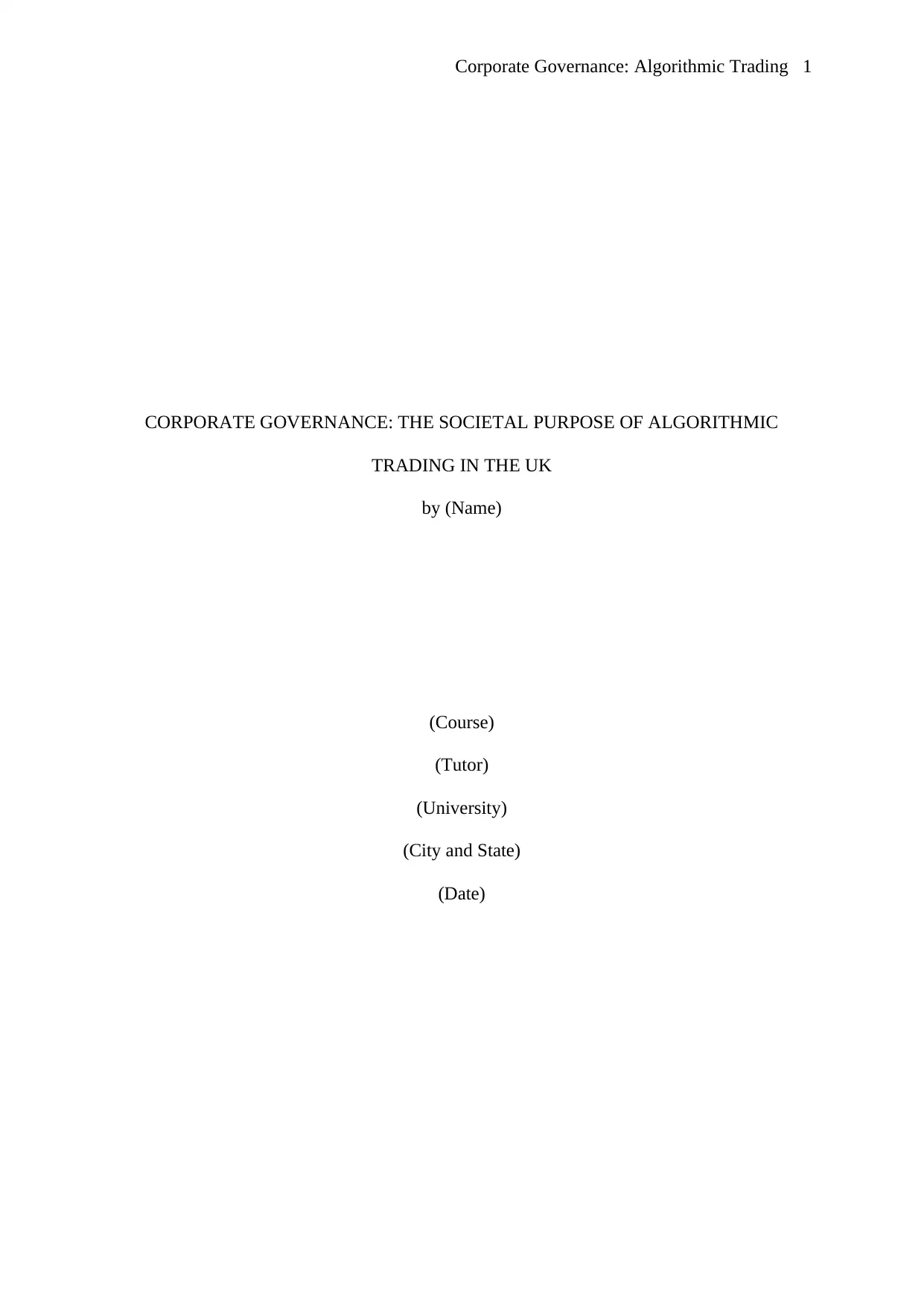
Corporate Governance: Algorithmic Trading 1
CORPORATE GOVERNANCE: THE SOCIETAL PURPOSE OF ALGORITHMIC
TRADING IN THE UK
by (Name)
(Course)
(Tutor)
(University)
(City and State)
(Date)
CORPORATE GOVERNANCE: THE SOCIETAL PURPOSE OF ALGORITHMIC
TRADING IN THE UK
by (Name)
(Course)
(Tutor)
(University)
(City and State)
(Date)
Paraphrase This Document
Need a fresh take? Get an instant paraphrase of this document with our AI Paraphraser
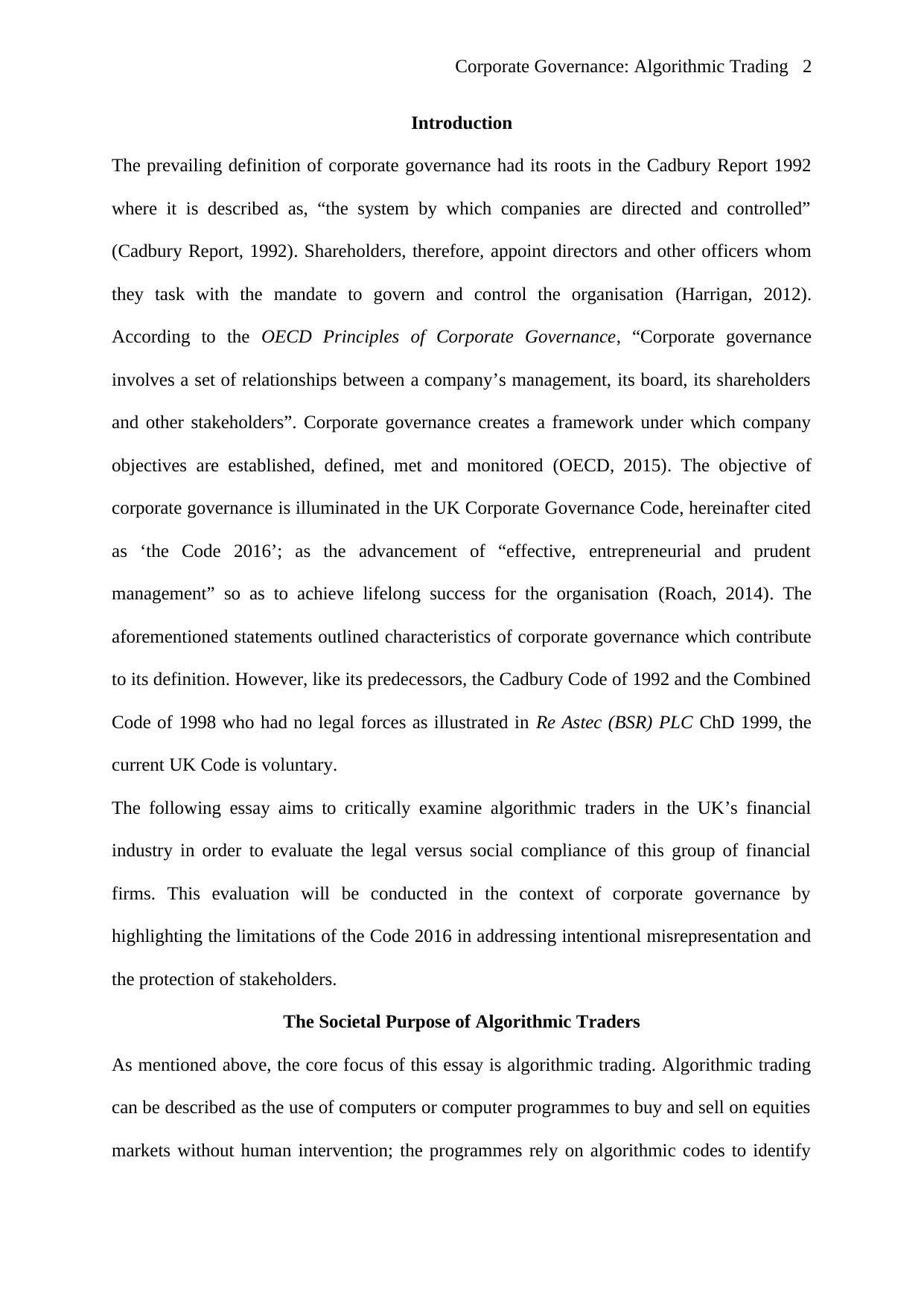
Corporate Governance: Algorithmic Trading 2
Introduction
The prevailing definition of corporate governance had its roots in the Cadbury Report 1992
where it is described as, “the system by which companies are directed and controlled”
(Cadbury Report, 1992). Shareholders, therefore, appoint directors and other officers whom
they task with the mandate to govern and control the organisation (Harrigan, 2012).
According to the OECD Principles of Corporate Governance, “Corporate governance
involves a set of relationships between a company’s management, its board, its shareholders
and other stakeholders”. Corporate governance creates a framework under which company
objectives are established, defined, met and monitored (OECD, 2015). The objective of
corporate governance is illuminated in the UK Corporate Governance Code, hereinafter cited
as ‘the Code 2016’; as the advancement of “effective, entrepreneurial and prudent
management” so as to achieve lifelong success for the organisation (Roach, 2014). The
aforementioned statements outlined characteristics of corporate governance which contribute
to its definition. However, like its predecessors, the Cadbury Code of 1992 and the Combined
Code of 1998 who had no legal forces as illustrated in Re Astec (BSR) PLC ChD 1999, the
current UK Code is voluntary.
The following essay aims to critically examine algorithmic traders in the UK’s financial
industry in order to evaluate the legal versus social compliance of this group of financial
firms. This evaluation will be conducted in the context of corporate governance by
highlighting the limitations of the Code 2016 in addressing intentional misrepresentation and
the protection of stakeholders.
The Societal Purpose of Algorithmic Traders
As mentioned above, the core focus of this essay is algorithmic trading. Algorithmic trading
can be described as the use of computers or computer programmes to buy and sell on equities
markets without human intervention; the programmes rely on algorithmic codes to identify
Introduction
The prevailing definition of corporate governance had its roots in the Cadbury Report 1992
where it is described as, “the system by which companies are directed and controlled”
(Cadbury Report, 1992). Shareholders, therefore, appoint directors and other officers whom
they task with the mandate to govern and control the organisation (Harrigan, 2012).
According to the OECD Principles of Corporate Governance, “Corporate governance
involves a set of relationships between a company’s management, its board, its shareholders
and other stakeholders”. Corporate governance creates a framework under which company
objectives are established, defined, met and monitored (OECD, 2015). The objective of
corporate governance is illuminated in the UK Corporate Governance Code, hereinafter cited
as ‘the Code 2016’; as the advancement of “effective, entrepreneurial and prudent
management” so as to achieve lifelong success for the organisation (Roach, 2014). The
aforementioned statements outlined characteristics of corporate governance which contribute
to its definition. However, like its predecessors, the Cadbury Code of 1992 and the Combined
Code of 1998 who had no legal forces as illustrated in Re Astec (BSR) PLC ChD 1999, the
current UK Code is voluntary.
The following essay aims to critically examine algorithmic traders in the UK’s financial
industry in order to evaluate the legal versus social compliance of this group of financial
firms. This evaluation will be conducted in the context of corporate governance by
highlighting the limitations of the Code 2016 in addressing intentional misrepresentation and
the protection of stakeholders.
The Societal Purpose of Algorithmic Traders
As mentioned above, the core focus of this essay is algorithmic trading. Algorithmic trading
can be described as the use of computers or computer programmes to buy and sell on equities
markets without human intervention; the programmes rely on algorithmic codes to identify
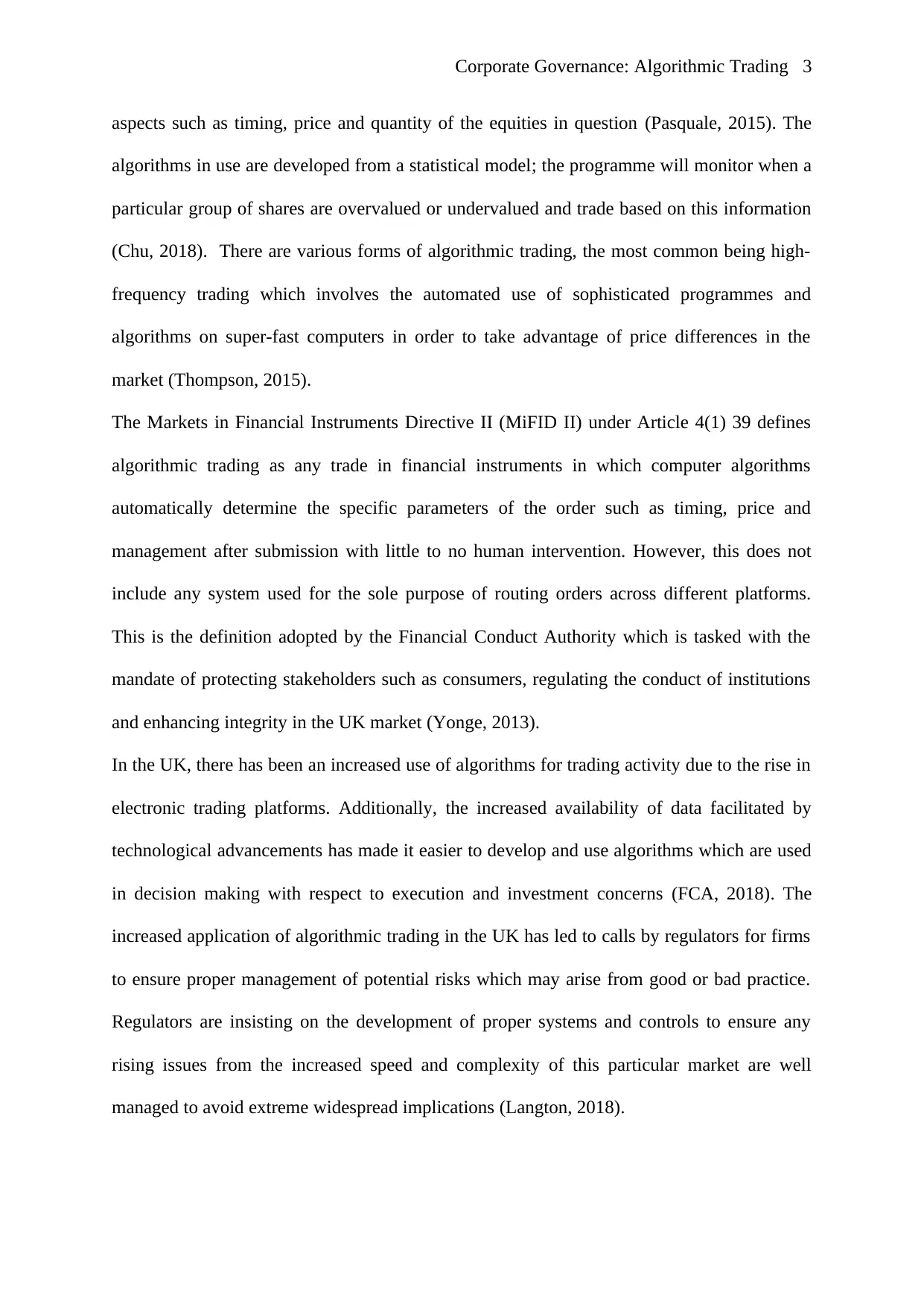
Corporate Governance: Algorithmic Trading 3
aspects such as timing, price and quantity of the equities in question (Pasquale, 2015). The
algorithms in use are developed from a statistical model; the programme will monitor when a
particular group of shares are overvalued or undervalued and trade based on this information
(Chu, 2018). There are various forms of algorithmic trading, the most common being high-
frequency trading which involves the automated use of sophisticated programmes and
algorithms on super-fast computers in order to take advantage of price differences in the
market (Thompson, 2015).
The Markets in Financial Instruments Directive II (MiFID II) under Article 4(1) 39 defines
algorithmic trading as any trade in financial instruments in which computer algorithms
automatically determine the specific parameters of the order such as timing, price and
management after submission with little to no human intervention. However, this does not
include any system used for the sole purpose of routing orders across different platforms.
This is the definition adopted by the Financial Conduct Authority which is tasked with the
mandate of protecting stakeholders such as consumers, regulating the conduct of institutions
and enhancing integrity in the UK market (Yonge, 2013).
In the UK, there has been an increased use of algorithms for trading activity due to the rise in
electronic trading platforms. Additionally, the increased availability of data facilitated by
technological advancements has made it easier to develop and use algorithms which are used
in decision making with respect to execution and investment concerns (FCA, 2018). The
increased application of algorithmic trading in the UK has led to calls by regulators for firms
to ensure proper management of potential risks which may arise from good or bad practice.
Regulators are insisting on the development of proper systems and controls to ensure any
rising issues from the increased speed and complexity of this particular market are well
managed to avoid extreme widespread implications (Langton, 2018).
aspects such as timing, price and quantity of the equities in question (Pasquale, 2015). The
algorithms in use are developed from a statistical model; the programme will monitor when a
particular group of shares are overvalued or undervalued and trade based on this information
(Chu, 2018). There are various forms of algorithmic trading, the most common being high-
frequency trading which involves the automated use of sophisticated programmes and
algorithms on super-fast computers in order to take advantage of price differences in the
market (Thompson, 2015).
The Markets in Financial Instruments Directive II (MiFID II) under Article 4(1) 39 defines
algorithmic trading as any trade in financial instruments in which computer algorithms
automatically determine the specific parameters of the order such as timing, price and
management after submission with little to no human intervention. However, this does not
include any system used for the sole purpose of routing orders across different platforms.
This is the definition adopted by the Financial Conduct Authority which is tasked with the
mandate of protecting stakeholders such as consumers, regulating the conduct of institutions
and enhancing integrity in the UK market (Yonge, 2013).
In the UK, there has been an increased use of algorithms for trading activity due to the rise in
electronic trading platforms. Additionally, the increased availability of data facilitated by
technological advancements has made it easier to develop and use algorithms which are used
in decision making with respect to execution and investment concerns (FCA, 2018). The
increased application of algorithmic trading in the UK has led to calls by regulators for firms
to ensure proper management of potential risks which may arise from good or bad practice.
Regulators are insisting on the development of proper systems and controls to ensure any
rising issues from the increased speed and complexity of this particular market are well
managed to avoid extreme widespread implications (Langton, 2018).
⊘ This is a preview!⊘
Do you want full access?
Subscribe today to unlock all pages.

Trusted by 1+ million students worldwide
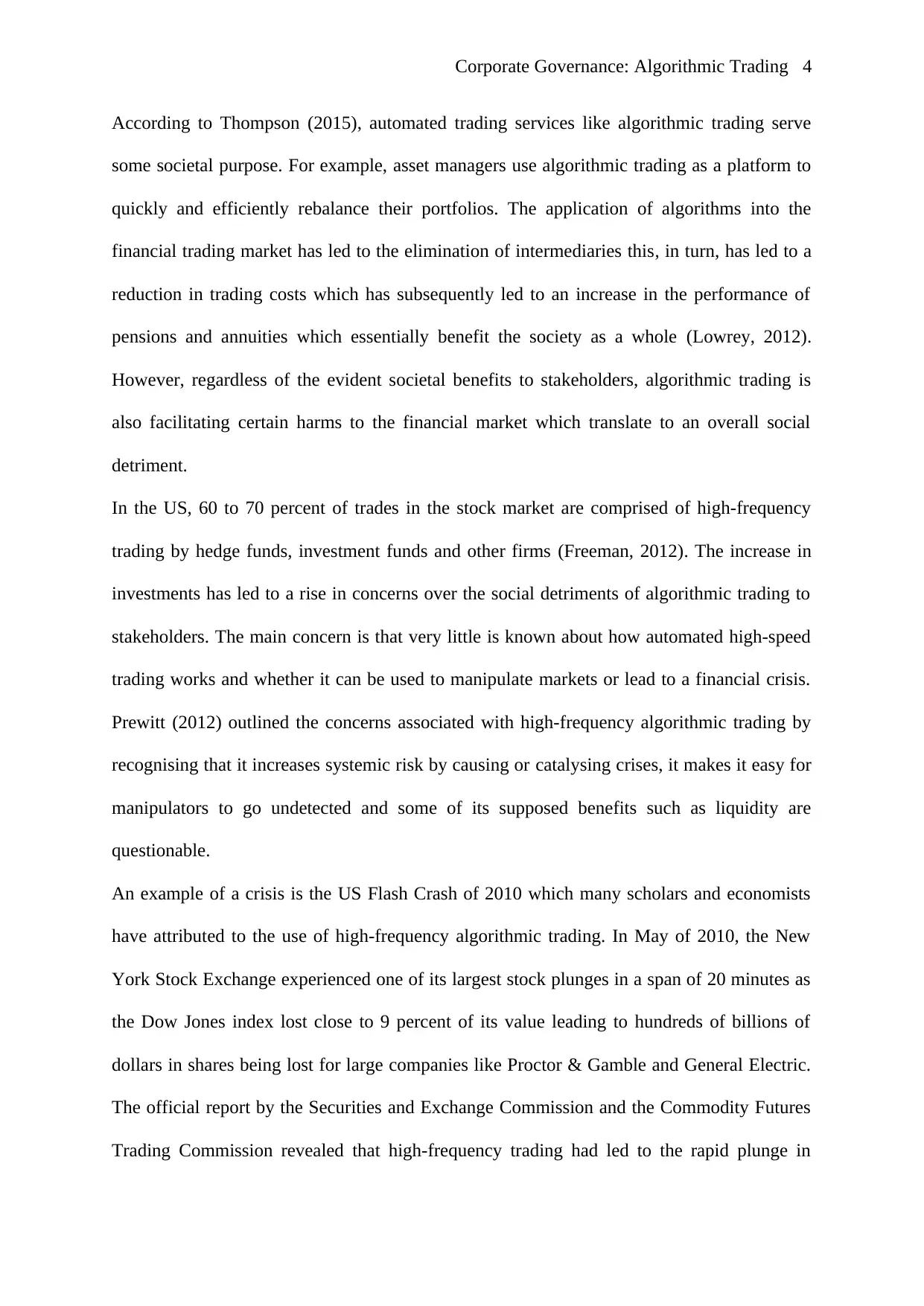
Corporate Governance: Algorithmic Trading 4
According to Thompson (2015), automated trading services like algorithmic trading serve
some societal purpose. For example, asset managers use algorithmic trading as a platform to
quickly and efficiently rebalance their portfolios. The application of algorithms into the
financial trading market has led to the elimination of intermediaries this, in turn, has led to a
reduction in trading costs which has subsequently led to an increase in the performance of
pensions and annuities which essentially benefit the society as a whole (Lowrey, 2012).
However, regardless of the evident societal benefits to stakeholders, algorithmic trading is
also facilitating certain harms to the financial market which translate to an overall social
detriment.
In the US, 60 to 70 percent of trades in the stock market are comprised of high-frequency
trading by hedge funds, investment funds and other firms (Freeman, 2012). The increase in
investments has led to a rise in concerns over the social detriments of algorithmic trading to
stakeholders. The main concern is that very little is known about how automated high-speed
trading works and whether it can be used to manipulate markets or lead to a financial crisis.
Prewitt (2012) outlined the concerns associated with high-frequency algorithmic trading by
recognising that it increases systemic risk by causing or catalysing crises, it makes it easy for
manipulators to go undetected and some of its supposed benefits such as liquidity are
questionable.
An example of a crisis is the US Flash Crash of 2010 which many scholars and economists
have attributed to the use of high-frequency algorithmic trading. In May of 2010, the New
York Stock Exchange experienced one of its largest stock plunges in a span of 20 minutes as
the Dow Jones index lost close to 9 percent of its value leading to hundreds of billions of
dollars in shares being lost for large companies like Proctor & Gamble and General Electric.
The official report by the Securities and Exchange Commission and the Commodity Futures
Trading Commission revealed that high-frequency trading had led to the rapid plunge in
According to Thompson (2015), automated trading services like algorithmic trading serve
some societal purpose. For example, asset managers use algorithmic trading as a platform to
quickly and efficiently rebalance their portfolios. The application of algorithms into the
financial trading market has led to the elimination of intermediaries this, in turn, has led to a
reduction in trading costs which has subsequently led to an increase in the performance of
pensions and annuities which essentially benefit the society as a whole (Lowrey, 2012).
However, regardless of the evident societal benefits to stakeholders, algorithmic trading is
also facilitating certain harms to the financial market which translate to an overall social
detriment.
In the US, 60 to 70 percent of trades in the stock market are comprised of high-frequency
trading by hedge funds, investment funds and other firms (Freeman, 2012). The increase in
investments has led to a rise in concerns over the social detriments of algorithmic trading to
stakeholders. The main concern is that very little is known about how automated high-speed
trading works and whether it can be used to manipulate markets or lead to a financial crisis.
Prewitt (2012) outlined the concerns associated with high-frequency algorithmic trading by
recognising that it increases systemic risk by causing or catalysing crises, it makes it easy for
manipulators to go undetected and some of its supposed benefits such as liquidity are
questionable.
An example of a crisis is the US Flash Crash of 2010 which many scholars and economists
have attributed to the use of high-frequency algorithmic trading. In May of 2010, the New
York Stock Exchange experienced one of its largest stock plunges in a span of 20 minutes as
the Dow Jones index lost close to 9 percent of its value leading to hundreds of billions of
dollars in shares being lost for large companies like Proctor & Gamble and General Electric.
The official report by the Securities and Exchange Commission and the Commodity Futures
Trading Commission revealed that high-frequency trading had led to the rapid plunge in
Paraphrase This Document
Need a fresh take? Get an instant paraphrase of this document with our AI Paraphraser
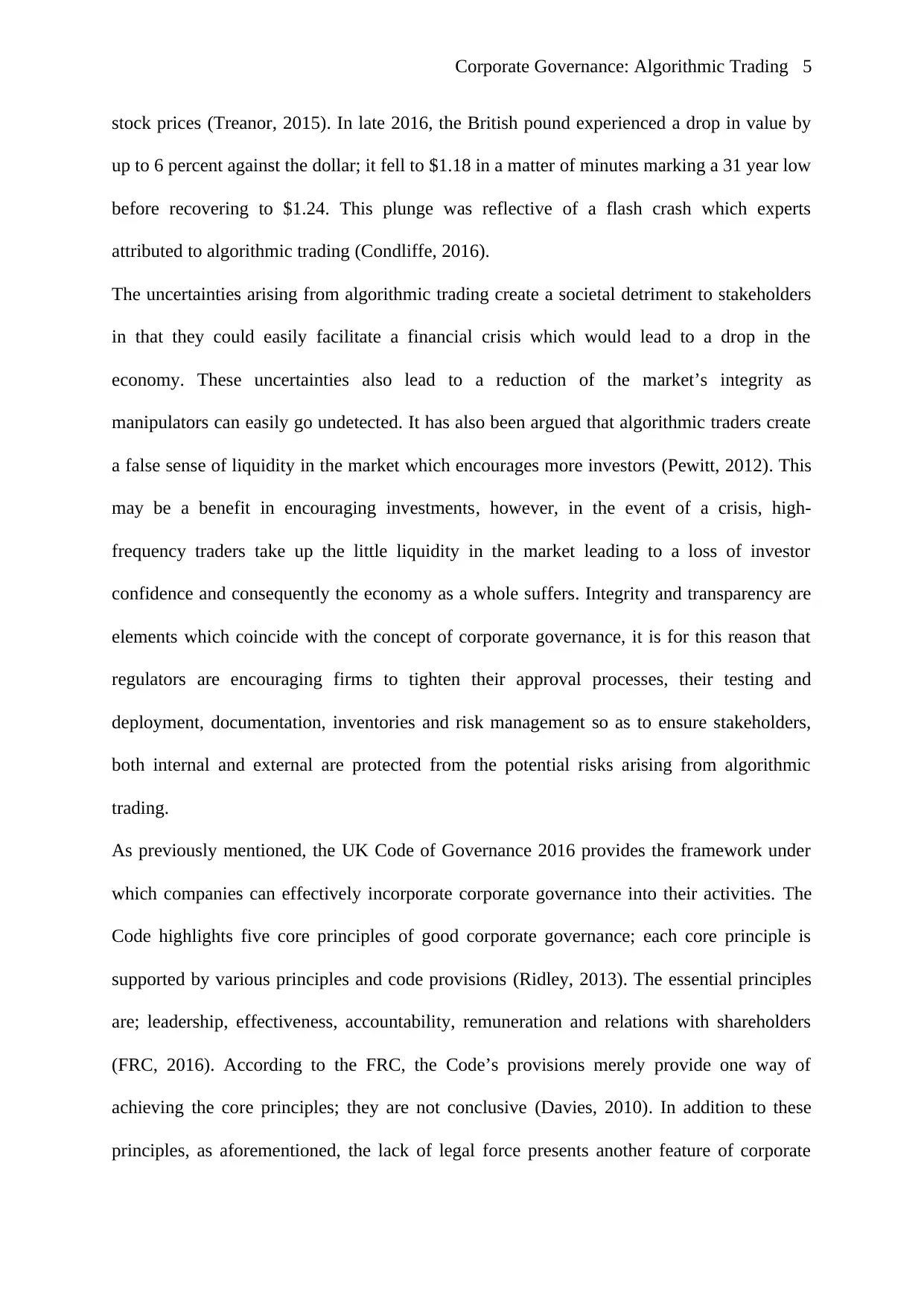
Corporate Governance: Algorithmic Trading 5
stock prices (Treanor, 2015). In late 2016, the British pound experienced a drop in value by
up to 6 percent against the dollar; it fell to $1.18 in a matter of minutes marking a 31 year low
before recovering to $1.24. This plunge was reflective of a flash crash which experts
attributed to algorithmic trading (Condliffe, 2016).
The uncertainties arising from algorithmic trading create a societal detriment to stakeholders
in that they could easily facilitate a financial crisis which would lead to a drop in the
economy. These uncertainties also lead to a reduction of the market’s integrity as
manipulators can easily go undetected. It has also been argued that algorithmic traders create
a false sense of liquidity in the market which encourages more investors (Pewitt, 2012). This
may be a benefit in encouraging investments, however, in the event of a crisis, high-
frequency traders take up the little liquidity in the market leading to a loss of investor
confidence and consequently the economy as a whole suffers. Integrity and transparency are
elements which coincide with the concept of corporate governance, it is for this reason that
regulators are encouraging firms to tighten their approval processes, their testing and
deployment, documentation, inventories and risk management so as to ensure stakeholders,
both internal and external are protected from the potential risks arising from algorithmic
trading.
As previously mentioned, the UK Code of Governance 2016 provides the framework under
which companies can effectively incorporate corporate governance into their activities. The
Code highlights five core principles of good corporate governance; each core principle is
supported by various principles and code provisions (Ridley, 2013). The essential principles
are; leadership, effectiveness, accountability, remuneration and relations with shareholders
(FRC, 2016). According to the FRC, the Code’s provisions merely provide one way of
achieving the core principles; they are not conclusive (Davies, 2010). In addition to these
principles, as aforementioned, the lack of legal force presents another feature of corporate
stock prices (Treanor, 2015). In late 2016, the British pound experienced a drop in value by
up to 6 percent against the dollar; it fell to $1.18 in a matter of minutes marking a 31 year low
before recovering to $1.24. This plunge was reflective of a flash crash which experts
attributed to algorithmic trading (Condliffe, 2016).
The uncertainties arising from algorithmic trading create a societal detriment to stakeholders
in that they could easily facilitate a financial crisis which would lead to a drop in the
economy. These uncertainties also lead to a reduction of the market’s integrity as
manipulators can easily go undetected. It has also been argued that algorithmic traders create
a false sense of liquidity in the market which encourages more investors (Pewitt, 2012). This
may be a benefit in encouraging investments, however, in the event of a crisis, high-
frequency traders take up the little liquidity in the market leading to a loss of investor
confidence and consequently the economy as a whole suffers. Integrity and transparency are
elements which coincide with the concept of corporate governance, it is for this reason that
regulators are encouraging firms to tighten their approval processes, their testing and
deployment, documentation, inventories and risk management so as to ensure stakeholders,
both internal and external are protected from the potential risks arising from algorithmic
trading.
As previously mentioned, the UK Code of Governance 2016 provides the framework under
which companies can effectively incorporate corporate governance into their activities. The
Code highlights five core principles of good corporate governance; each core principle is
supported by various principles and code provisions (Ridley, 2013). The essential principles
are; leadership, effectiveness, accountability, remuneration and relations with shareholders
(FRC, 2016). According to the FRC, the Code’s provisions merely provide one way of
achieving the core principles; they are not conclusive (Davies, 2010). In addition to these
principles, as aforementioned, the lack of legal force presents another feature of corporate
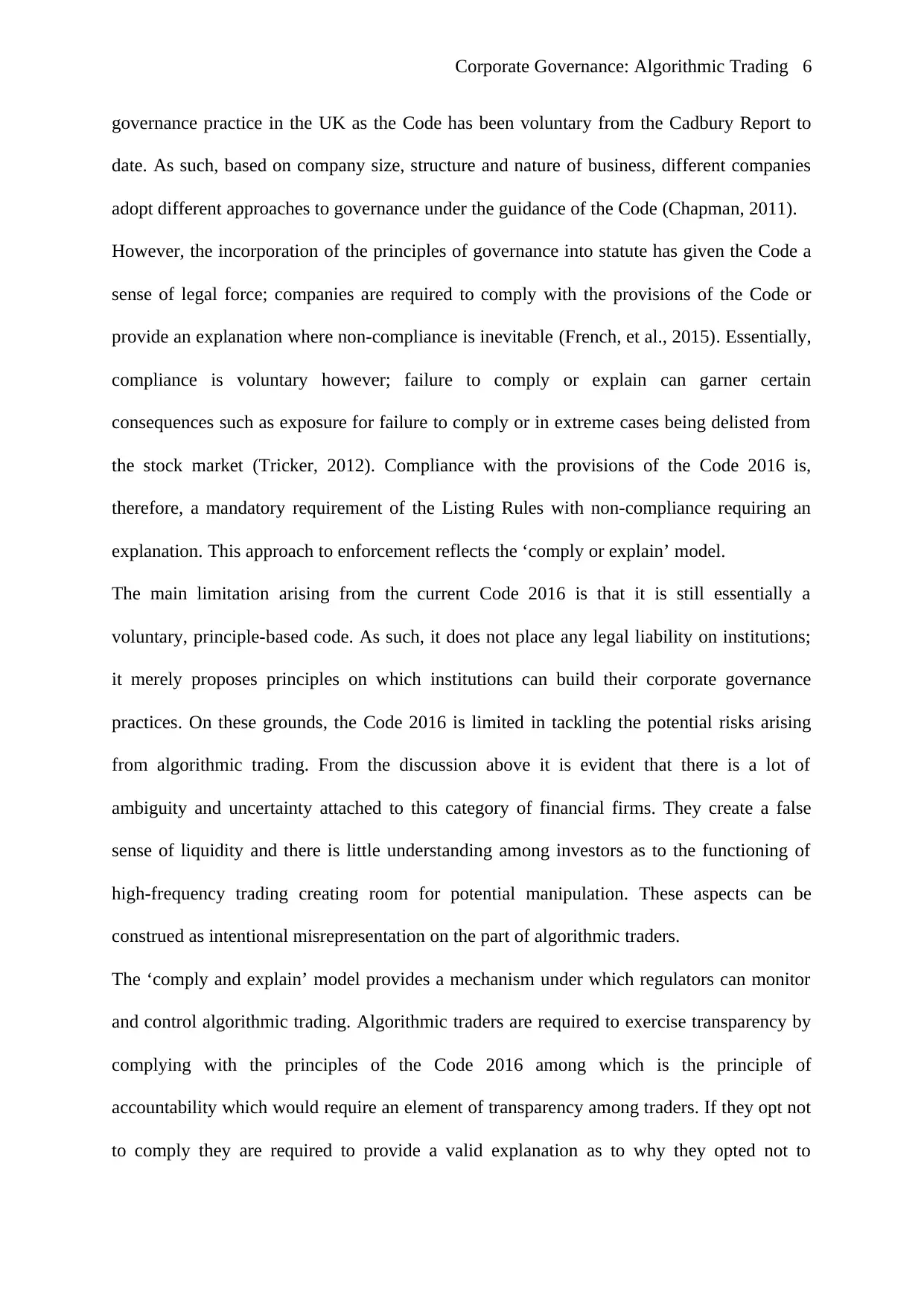
Corporate Governance: Algorithmic Trading 6
governance practice in the UK as the Code has been voluntary from the Cadbury Report to
date. As such, based on company size, structure and nature of business, different companies
adopt different approaches to governance under the guidance of the Code (Chapman, 2011).
However, the incorporation of the principles of governance into statute has given the Code a
sense of legal force; companies are required to comply with the provisions of the Code or
provide an explanation where non-compliance is inevitable (French, et al., 2015). Essentially,
compliance is voluntary however; failure to comply or explain can garner certain
consequences such as exposure for failure to comply or in extreme cases being delisted from
the stock market (Tricker, 2012). Compliance with the provisions of the Code 2016 is,
therefore, a mandatory requirement of the Listing Rules with non-compliance requiring an
explanation. This approach to enforcement reflects the ‘comply or explain’ model.
The main limitation arising from the current Code 2016 is that it is still essentially a
voluntary, principle-based code. As such, it does not place any legal liability on institutions;
it merely proposes principles on which institutions can build their corporate governance
practices. On these grounds, the Code 2016 is limited in tackling the potential risks arising
from algorithmic trading. From the discussion above it is evident that there is a lot of
ambiguity and uncertainty attached to this category of financial firms. They create a false
sense of liquidity and there is little understanding among investors as to the functioning of
high-frequency trading creating room for potential manipulation. These aspects can be
construed as intentional misrepresentation on the part of algorithmic traders.
The ‘comply and explain’ model provides a mechanism under which regulators can monitor
and control algorithmic trading. Algorithmic traders are required to exercise transparency by
complying with the principles of the Code 2016 among which is the principle of
accountability which would require an element of transparency among traders. If they opt not
to comply they are required to provide a valid explanation as to why they opted not to
governance practice in the UK as the Code has been voluntary from the Cadbury Report to
date. As such, based on company size, structure and nature of business, different companies
adopt different approaches to governance under the guidance of the Code (Chapman, 2011).
However, the incorporation of the principles of governance into statute has given the Code a
sense of legal force; companies are required to comply with the provisions of the Code or
provide an explanation where non-compliance is inevitable (French, et al., 2015). Essentially,
compliance is voluntary however; failure to comply or explain can garner certain
consequences such as exposure for failure to comply or in extreme cases being delisted from
the stock market (Tricker, 2012). Compliance with the provisions of the Code 2016 is,
therefore, a mandatory requirement of the Listing Rules with non-compliance requiring an
explanation. This approach to enforcement reflects the ‘comply or explain’ model.
The main limitation arising from the current Code 2016 is that it is still essentially a
voluntary, principle-based code. As such, it does not place any legal liability on institutions;
it merely proposes principles on which institutions can build their corporate governance
practices. On these grounds, the Code 2016 is limited in tackling the potential risks arising
from algorithmic trading. From the discussion above it is evident that there is a lot of
ambiguity and uncertainty attached to this category of financial firms. They create a false
sense of liquidity and there is little understanding among investors as to the functioning of
high-frequency trading creating room for potential manipulation. These aspects can be
construed as intentional misrepresentation on the part of algorithmic traders.
The ‘comply and explain’ model provides a mechanism under which regulators can monitor
and control algorithmic trading. Algorithmic traders are required to exercise transparency by
complying with the principles of the Code 2016 among which is the principle of
accountability which would require an element of transparency among traders. If they opt not
to comply they are required to provide a valid explanation as to why they opted not to
⊘ This is a preview!⊘
Do you want full access?
Subscribe today to unlock all pages.

Trusted by 1+ million students worldwide
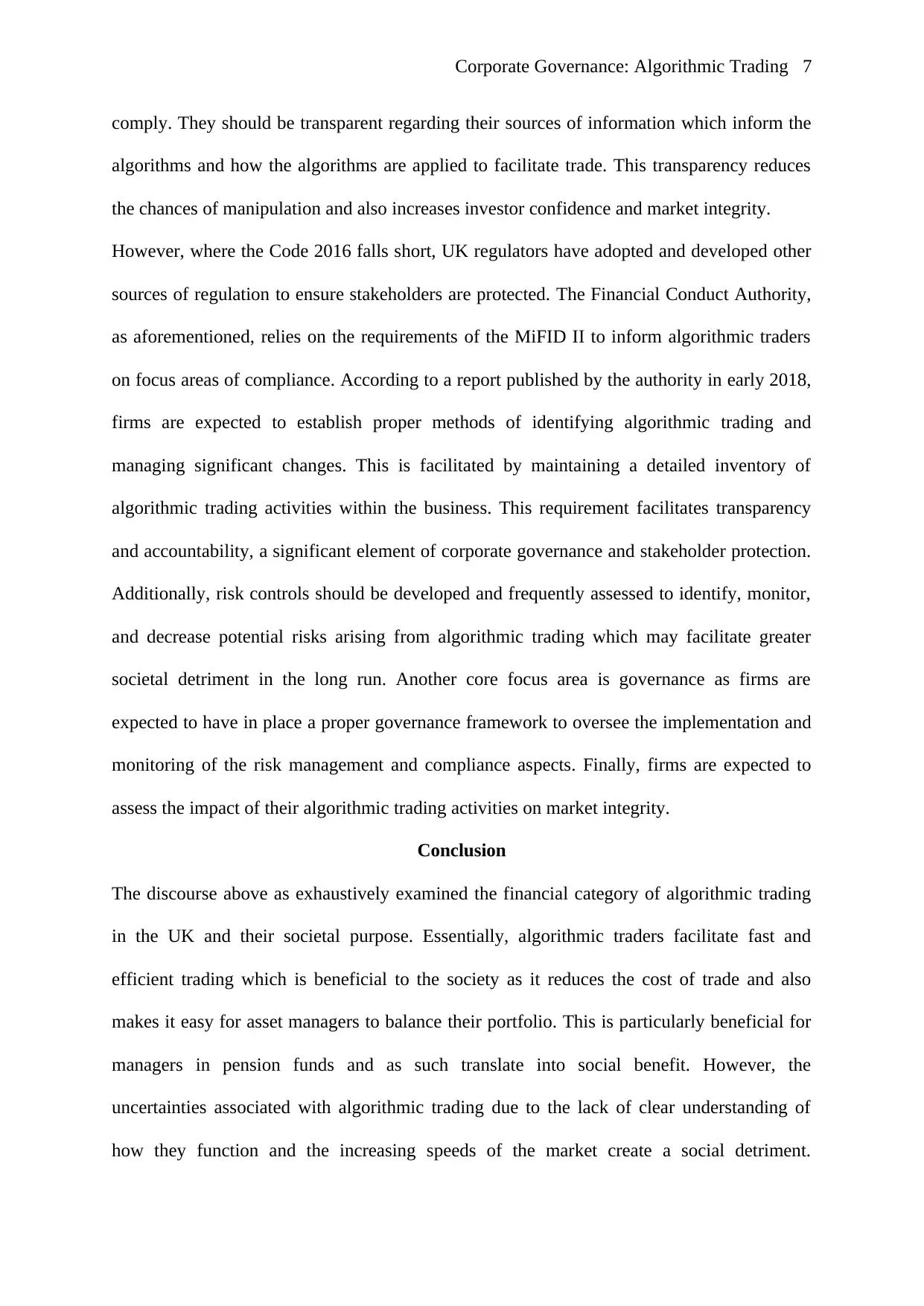
Corporate Governance: Algorithmic Trading 7
comply. They should be transparent regarding their sources of information which inform the
algorithms and how the algorithms are applied to facilitate trade. This transparency reduces
the chances of manipulation and also increases investor confidence and market integrity.
However, where the Code 2016 falls short, UK regulators have adopted and developed other
sources of regulation to ensure stakeholders are protected. The Financial Conduct Authority,
as aforementioned, relies on the requirements of the MiFID II to inform algorithmic traders
on focus areas of compliance. According to a report published by the authority in early 2018,
firms are expected to establish proper methods of identifying algorithmic trading and
managing significant changes. This is facilitated by maintaining a detailed inventory of
algorithmic trading activities within the business. This requirement facilitates transparency
and accountability, a significant element of corporate governance and stakeholder protection.
Additionally, risk controls should be developed and frequently assessed to identify, monitor,
and decrease potential risks arising from algorithmic trading which may facilitate greater
societal detriment in the long run. Another core focus area is governance as firms are
expected to have in place a proper governance framework to oversee the implementation and
monitoring of the risk management and compliance aspects. Finally, firms are expected to
assess the impact of their algorithmic trading activities on market integrity.
Conclusion
The discourse above as exhaustively examined the financial category of algorithmic trading
in the UK and their societal purpose. Essentially, algorithmic traders facilitate fast and
efficient trading which is beneficial to the society as it reduces the cost of trade and also
makes it easy for asset managers to balance their portfolio. This is particularly beneficial for
managers in pension funds and as such translate into social benefit. However, the
uncertainties associated with algorithmic trading due to the lack of clear understanding of
how they function and the increasing speeds of the market create a social detriment.
comply. They should be transparent regarding their sources of information which inform the
algorithms and how the algorithms are applied to facilitate trade. This transparency reduces
the chances of manipulation and also increases investor confidence and market integrity.
However, where the Code 2016 falls short, UK regulators have adopted and developed other
sources of regulation to ensure stakeholders are protected. The Financial Conduct Authority,
as aforementioned, relies on the requirements of the MiFID II to inform algorithmic traders
on focus areas of compliance. According to a report published by the authority in early 2018,
firms are expected to establish proper methods of identifying algorithmic trading and
managing significant changes. This is facilitated by maintaining a detailed inventory of
algorithmic trading activities within the business. This requirement facilitates transparency
and accountability, a significant element of corporate governance and stakeholder protection.
Additionally, risk controls should be developed and frequently assessed to identify, monitor,
and decrease potential risks arising from algorithmic trading which may facilitate greater
societal detriment in the long run. Another core focus area is governance as firms are
expected to have in place a proper governance framework to oversee the implementation and
monitoring of the risk management and compliance aspects. Finally, firms are expected to
assess the impact of their algorithmic trading activities on market integrity.
Conclusion
The discourse above as exhaustively examined the financial category of algorithmic trading
in the UK and their societal purpose. Essentially, algorithmic traders facilitate fast and
efficient trading which is beneficial to the society as it reduces the cost of trade and also
makes it easy for asset managers to balance their portfolio. This is particularly beneficial for
managers in pension funds and as such translate into social benefit. However, the
uncertainties associated with algorithmic trading due to the lack of clear understanding of
how they function and the increasing speeds of the market create a social detriment.
Paraphrase This Document
Need a fresh take? Get an instant paraphrase of this document with our AI Paraphraser
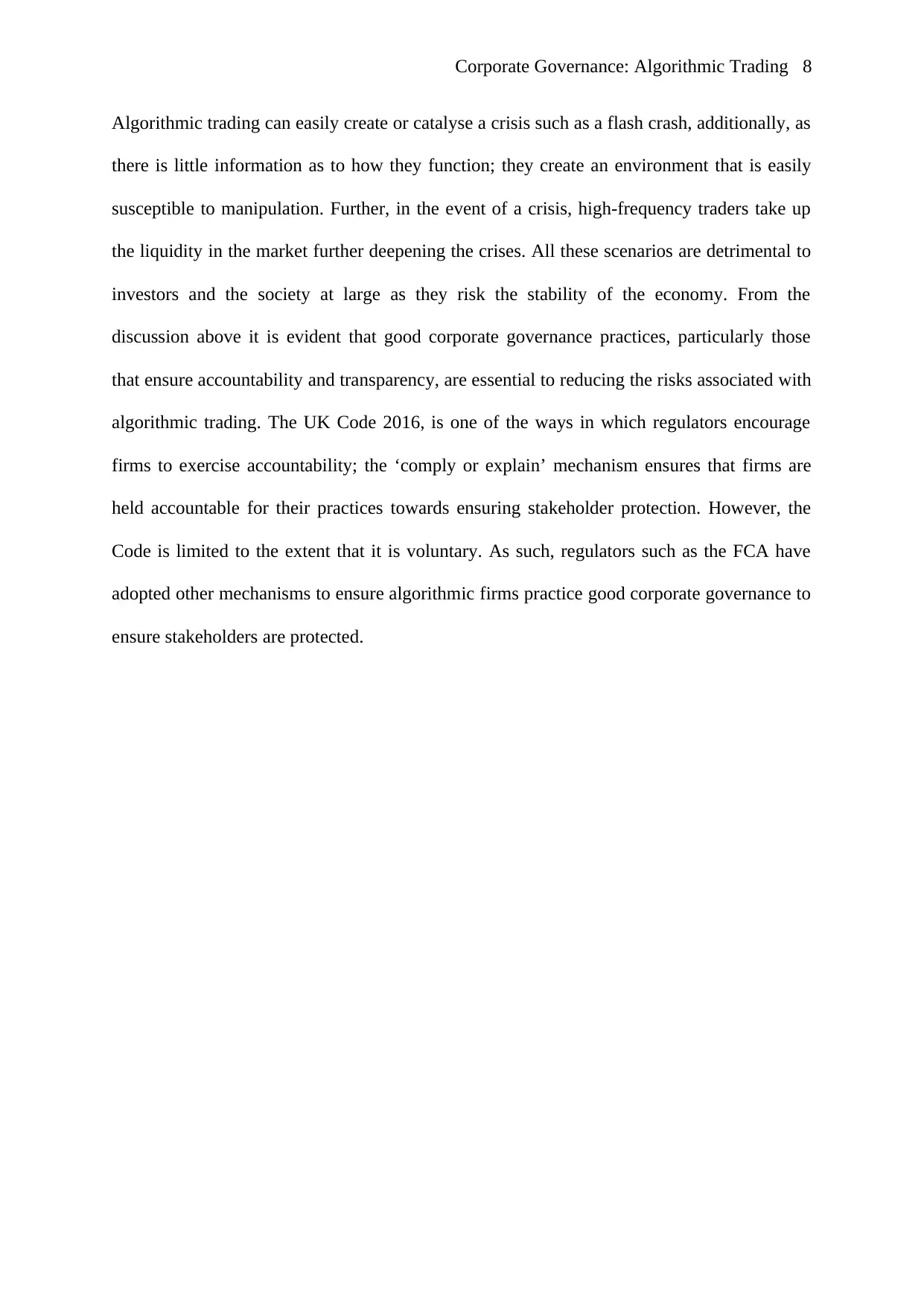
Corporate Governance: Algorithmic Trading 8
Algorithmic trading can easily create or catalyse a crisis such as a flash crash, additionally, as
there is little information as to how they function; they create an environment that is easily
susceptible to manipulation. Further, in the event of a crisis, high-frequency traders take up
the liquidity in the market further deepening the crises. All these scenarios are detrimental to
investors and the society at large as they risk the stability of the economy. From the
discussion above it is evident that good corporate governance practices, particularly those
that ensure accountability and transparency, are essential to reducing the risks associated with
algorithmic trading. The UK Code 2016, is one of the ways in which regulators encourage
firms to exercise accountability; the ‘comply or explain’ mechanism ensures that firms are
held accountable for their practices towards ensuring stakeholder protection. However, the
Code is limited to the extent that it is voluntary. As such, regulators such as the FCA have
adopted other mechanisms to ensure algorithmic firms practice good corporate governance to
ensure stakeholders are protected.
Algorithmic trading can easily create or catalyse a crisis such as a flash crash, additionally, as
there is little information as to how they function; they create an environment that is easily
susceptible to manipulation. Further, in the event of a crisis, high-frequency traders take up
the liquidity in the market further deepening the crises. All these scenarios are detrimental to
investors and the society at large as they risk the stability of the economy. From the
discussion above it is evident that good corporate governance practices, particularly those
that ensure accountability and transparency, are essential to reducing the risks associated with
algorithmic trading. The UK Code 2016, is one of the ways in which regulators encourage
firms to exercise accountability; the ‘comply or explain’ mechanism ensures that firms are
held accountable for their practices towards ensuring stakeholder protection. However, the
Code is limited to the extent that it is voluntary. As such, regulators such as the FCA have
adopted other mechanisms to ensure algorithmic firms practice good corporate governance to
ensure stakeholders are protected.
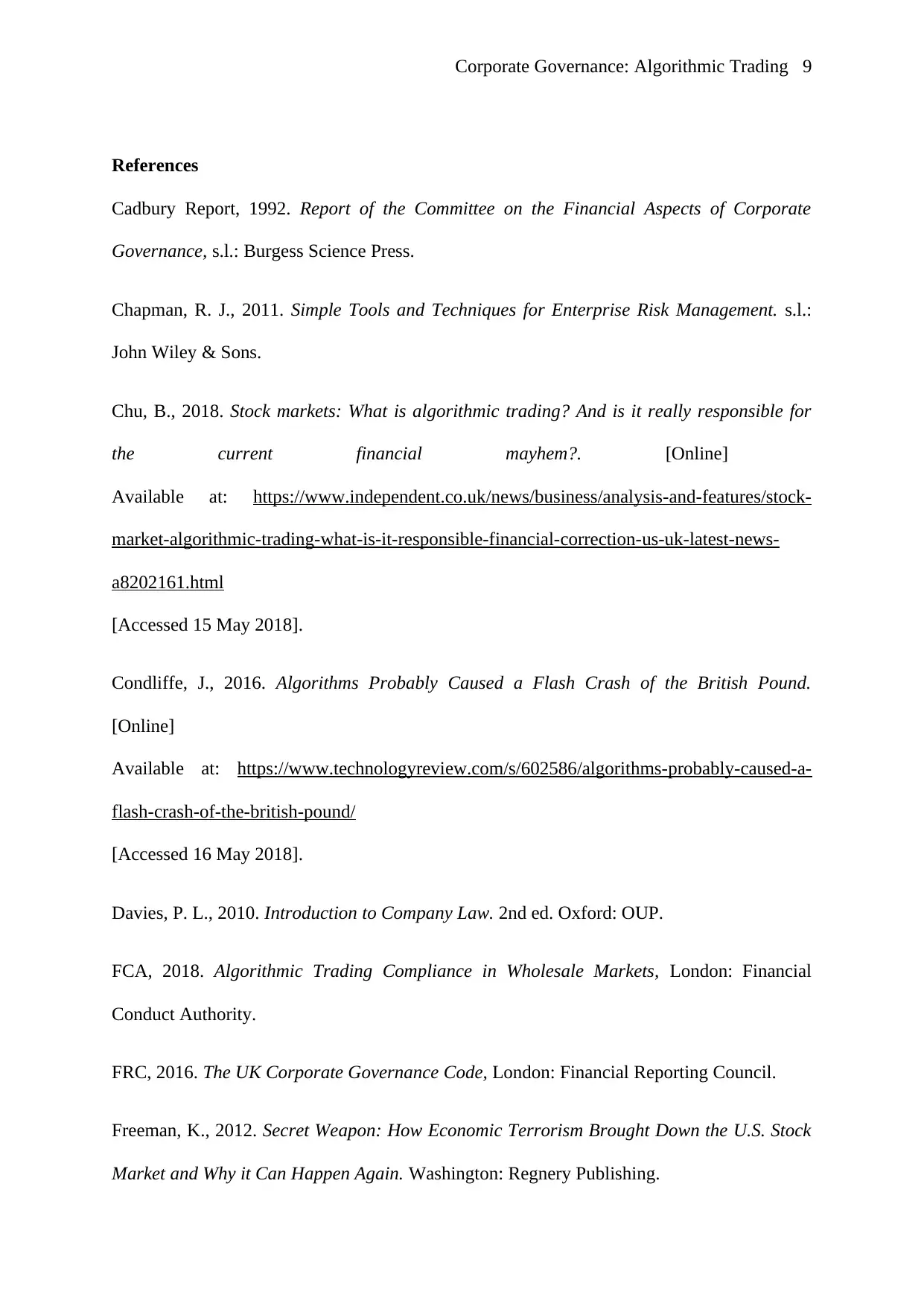
Corporate Governance: Algorithmic Trading 9
References
Cadbury Report, 1992. Report of the Committee on the Financial Aspects of Corporate
Governance, s.l.: Burgess Science Press.
Chapman, R. J., 2011. Simple Tools and Techniques for Enterprise Risk Management. s.l.:
John Wiley & Sons.
Chu, B., 2018. Stock markets: What is algorithmic trading? And is it really responsible for
the current financial mayhem?. [Online]
Available at: https://www.independent.co.uk/news/business/analysis-and-features/stock-
market-algorithmic-trading-what-is-it-responsible-financial-correction-us-uk-latest-news-
a8202161.html
[Accessed 15 May 2018].
Condliffe, J., 2016. Algorithms Probably Caused a Flash Crash of the British Pound.
[Online]
Available at: https://www.technologyreview.com/s/602586/algorithms-probably-caused-a-
flash-crash-of-the-british-pound/
[Accessed 16 May 2018].
Davies, P. L., 2010. Introduction to Company Law. 2nd ed. Oxford: OUP.
FCA, 2018. Algorithmic Trading Compliance in Wholesale Markets, London: Financial
Conduct Authority.
FRC, 2016. The UK Corporate Governance Code, London: Financial Reporting Council.
Freeman, K., 2012. Secret Weapon: How Economic Terrorism Brought Down the U.S. Stock
Market and Why it Can Happen Again. Washington: Regnery Publishing.
References
Cadbury Report, 1992. Report of the Committee on the Financial Aspects of Corporate
Governance, s.l.: Burgess Science Press.
Chapman, R. J., 2011. Simple Tools and Techniques for Enterprise Risk Management. s.l.:
John Wiley & Sons.
Chu, B., 2018. Stock markets: What is algorithmic trading? And is it really responsible for
the current financial mayhem?. [Online]
Available at: https://www.independent.co.uk/news/business/analysis-and-features/stock-
market-algorithmic-trading-what-is-it-responsible-financial-correction-us-uk-latest-news-
a8202161.html
[Accessed 15 May 2018].
Condliffe, J., 2016. Algorithms Probably Caused a Flash Crash of the British Pound.
[Online]
Available at: https://www.technologyreview.com/s/602586/algorithms-probably-caused-a-
flash-crash-of-the-british-pound/
[Accessed 16 May 2018].
Davies, P. L., 2010. Introduction to Company Law. 2nd ed. Oxford: OUP.
FCA, 2018. Algorithmic Trading Compliance in Wholesale Markets, London: Financial
Conduct Authority.
FRC, 2016. The UK Corporate Governance Code, London: Financial Reporting Council.
Freeman, K., 2012. Secret Weapon: How Economic Terrorism Brought Down the U.S. Stock
Market and Why it Can Happen Again. Washington: Regnery Publishing.
⊘ This is a preview!⊘
Do you want full access?
Subscribe today to unlock all pages.

Trusted by 1+ million students worldwide
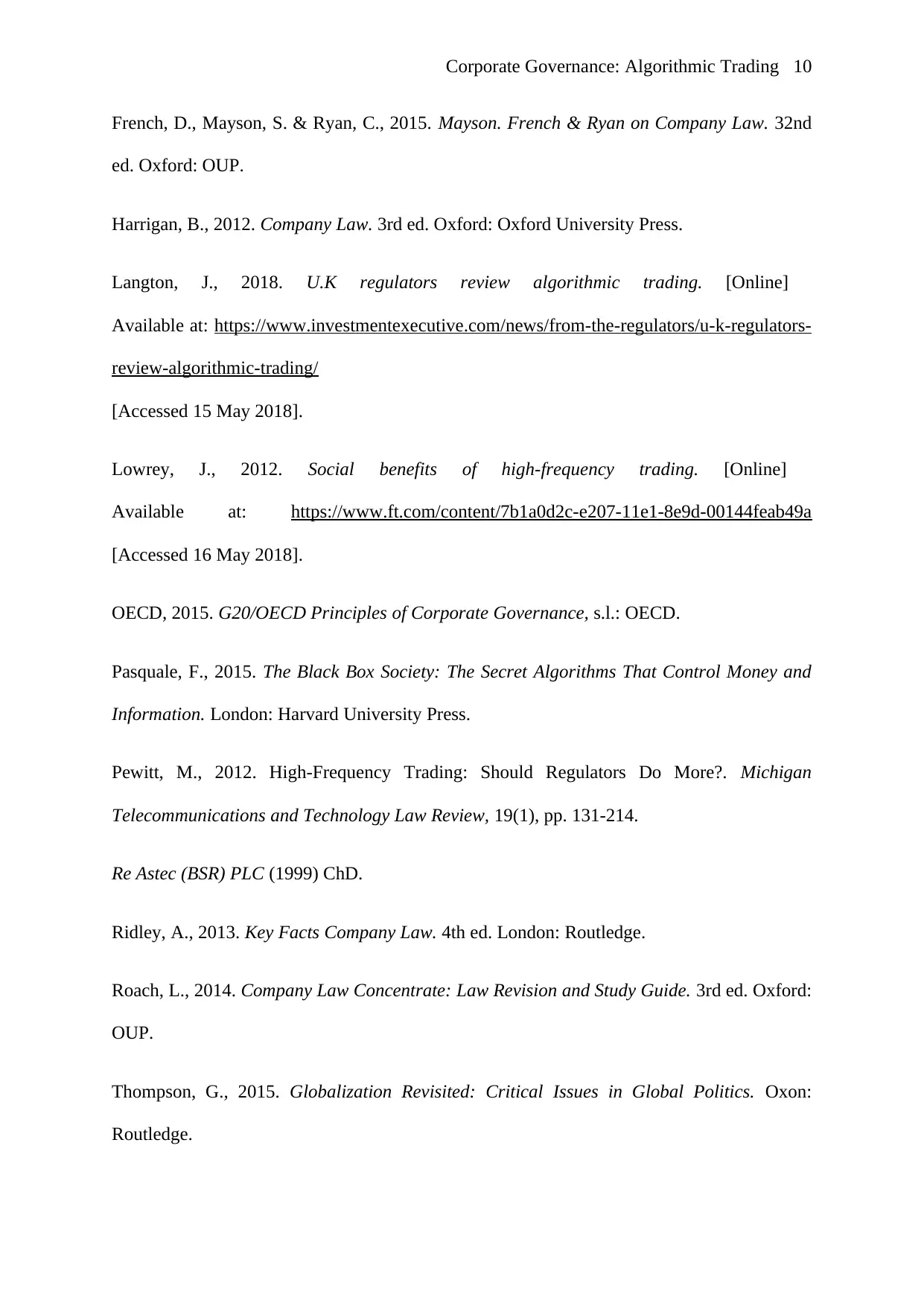
Corporate Governance: Algorithmic Trading 10
French, D., Mayson, S. & Ryan, C., 2015. Mayson. French & Ryan on Company Law. 32nd
ed. Oxford: OUP.
Harrigan, B., 2012. Company Law. 3rd ed. Oxford: Oxford University Press.
Langton, J., 2018. U.K regulators review algorithmic trading. [Online]
Available at: https://www.investmentexecutive.com/news/from-the-regulators/u-k-regulators-
review-algorithmic-trading/
[Accessed 15 May 2018].
Lowrey, J., 2012. Social benefits of high-frequency trading. [Online]
Available at: https://www.ft.com/content/7b1a0d2c-e207-11e1-8e9d-00144feab49a
[Accessed 16 May 2018].
OECD, 2015. G20/OECD Principles of Corporate Governance, s.l.: OECD.
Pasquale, F., 2015. The Black Box Society: The Secret Algorithms That Control Money and
Information. London: Harvard University Press.
Pewitt, M., 2012. High-Frequency Trading: Should Regulators Do More?. Michigan
Telecommunications and Technology Law Review, 19(1), pp. 131-214.
Re Astec (BSR) PLC (1999) ChD.
Ridley, A., 2013. Key Facts Company Law. 4th ed. London: Routledge.
Roach, L., 2014. Company Law Concentrate: Law Revision and Study Guide. 3rd ed. Oxford:
OUP.
Thompson, G., 2015. Globalization Revisited: Critical Issues in Global Politics. Oxon:
Routledge.
French, D., Mayson, S. & Ryan, C., 2015. Mayson. French & Ryan on Company Law. 32nd
ed. Oxford: OUP.
Harrigan, B., 2012. Company Law. 3rd ed. Oxford: Oxford University Press.
Langton, J., 2018. U.K regulators review algorithmic trading. [Online]
Available at: https://www.investmentexecutive.com/news/from-the-regulators/u-k-regulators-
review-algorithmic-trading/
[Accessed 15 May 2018].
Lowrey, J., 2012. Social benefits of high-frequency trading. [Online]
Available at: https://www.ft.com/content/7b1a0d2c-e207-11e1-8e9d-00144feab49a
[Accessed 16 May 2018].
OECD, 2015. G20/OECD Principles of Corporate Governance, s.l.: OECD.
Pasquale, F., 2015. The Black Box Society: The Secret Algorithms That Control Money and
Information. London: Harvard University Press.
Pewitt, M., 2012. High-Frequency Trading: Should Regulators Do More?. Michigan
Telecommunications and Technology Law Review, 19(1), pp. 131-214.
Re Astec (BSR) PLC (1999) ChD.
Ridley, A., 2013. Key Facts Company Law. 4th ed. London: Routledge.
Roach, L., 2014. Company Law Concentrate: Law Revision and Study Guide. 3rd ed. Oxford:
OUP.
Thompson, G., 2015. Globalization Revisited: Critical Issues in Global Politics. Oxon:
Routledge.
Paraphrase This Document
Need a fresh take? Get an instant paraphrase of this document with our AI Paraphraser
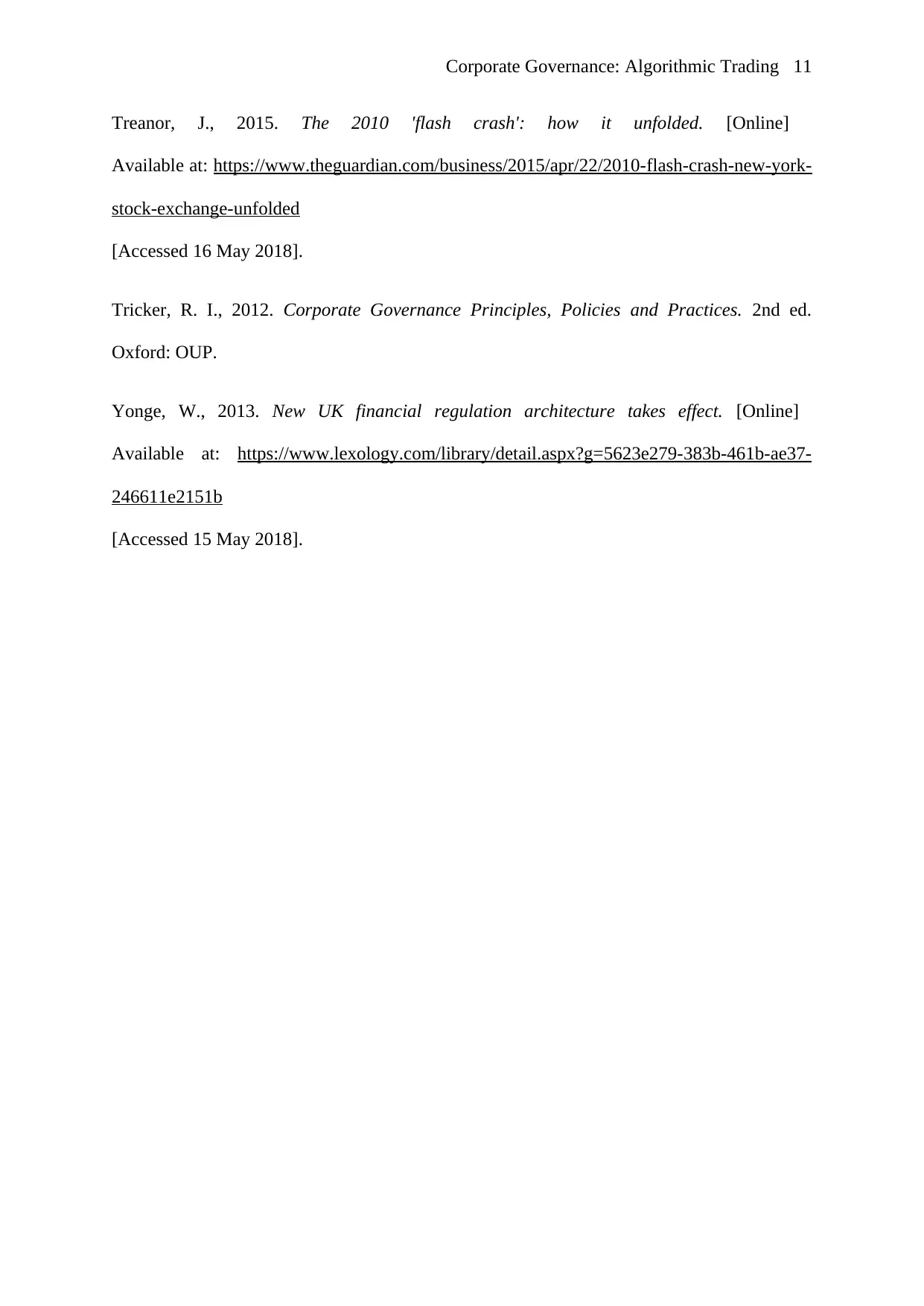
Corporate Governance: Algorithmic Trading 11
Treanor, J., 2015. The 2010 'flash crash': how it unfolded. [Online]
Available at: https://www.theguardian.com/business/2015/apr/22/2010-flash-crash-new-york-
stock-exchange-unfolded
[Accessed 16 May 2018].
Tricker, R. I., 2012. Corporate Governance Principles, Policies and Practices. 2nd ed.
Oxford: OUP.
Yonge, W., 2013. New UK financial regulation architecture takes effect. [Online]
Available at: https://www.lexology.com/library/detail.aspx?g=5623e279-383b-461b-ae37-
246611e2151b
[Accessed 15 May 2018].
Treanor, J., 2015. The 2010 'flash crash': how it unfolded. [Online]
Available at: https://www.theguardian.com/business/2015/apr/22/2010-flash-crash-new-york-
stock-exchange-unfolded
[Accessed 16 May 2018].
Tricker, R. I., 2012. Corporate Governance Principles, Policies and Practices. 2nd ed.
Oxford: OUP.
Yonge, W., 2013. New UK financial regulation architecture takes effect. [Online]
Available at: https://www.lexology.com/library/detail.aspx?g=5623e279-383b-461b-ae37-
246611e2151b
[Accessed 15 May 2018].
1 out of 11
Your All-in-One AI-Powered Toolkit for Academic Success.
+13062052269
info@desklib.com
Available 24*7 on WhatsApp / Email
![[object Object]](/_next/static/media/star-bottom.7253800d.svg)
Unlock your academic potential
Copyright © 2020–2025 A2Z Services. All Rights Reserved. Developed and managed by ZUCOL.
